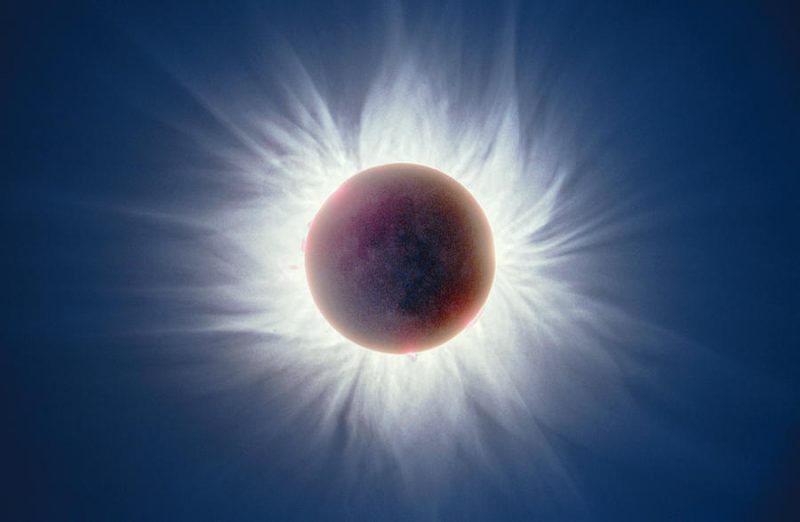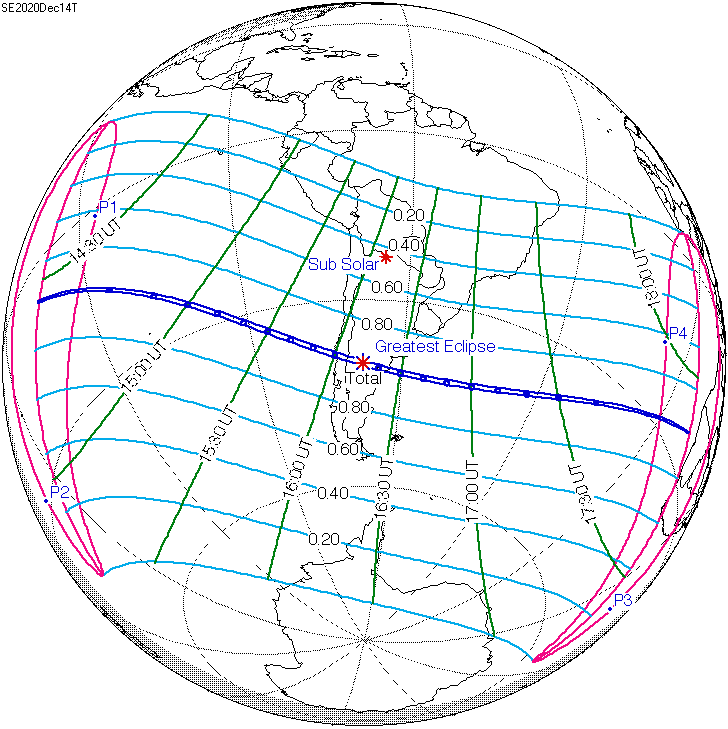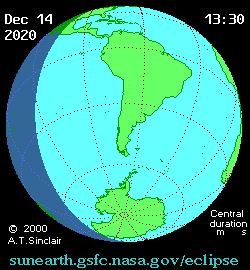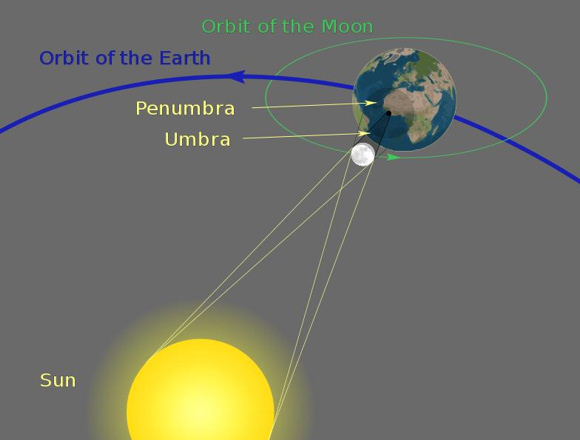

Composite image of a 1999 solar eclipse by Fred Espenak.
The new moon moves smack-dab in front of the sun on December 14, 2020, to present this year’s one and only total eclipse of the sun. This also counts as the final eclipse of the 202nd decade (2011 to 2020). Exactly six new moons previously – June 21, 2020 – the moon also passed right in front of the sun, but the new moon was too far distant to totally cover over the solar disk. So that resulted in an annular eclipse of the sun, whereby a thin ring of sunshine surrounds the new moon silhouette.
Read more: Annular solar eclipse on June 21, 2020
But back to the total solar eclipse of December 14, 2020. You have to be in the just right spot in southern South America (Chile and Argentina), or in the Pacific or Atlantic Oceans, to witness what is called nature’s grandest spectacle: the total eclipse of the sun. On a scale of 1 to 10, a total solar eclipse must rate somewhere around a million!
A much larger swath of the world (South America, Pacific and Atlantic Oceans, and even a portion of Antarctica) can watch varying degrees of a partial eclipse, as the moon takes a “bite” out of the solar disk. If you’re in a position to watch this eclipse – or any solar eclipse – remember that it’s absolutely essential to use proper eye protection during any partial solar eclipse. Only at totality – during the few minutes when the moon completely covers over the sun – is it safe to view with the eye alone.
Read more: Top 7 tips for safe solar eclipse viewing
For some idea of how the moon’s dark umbral shadow will sweep across the Earth’s surface for the only time this year, take a look at the map and animation below.

On a worldwide scale, the narrow path of the total eclipse path (thin blue line) starts at sunrise over the Pacific Ocean, and ends at sunset over the Atlantic Ocean – near the coast of Africa – some 3 1/3 hours and 9,200 miles (14,800 km) later. Outside the path of totality, the numbers (0.80, 0.60, 0.40, 0.20) indicate what fraction of the sun’s diameter will be covered over by the moon at greatest eclipse. Map via Fred Espenak.

On a worldwide scale, the eclipse starts over the Pacific Ocean and ends over the Atlantic Ocean. The small black dot shows the path of the total solar eclipse whereas the larger gray circle depicts the much broader path of the partial solar eclipse.
On a worldwide scale, the total eclipse lasts for 3 and 1/3 hours, starting at sunrise over the Pacific Ocean and ending at sunset over the Atlantic Ocean (near the coast of Africa). Yet, at anyone one point on the total eclipse path, the maximum duration for totality is just shy of 2 minutes and 10 seconds long. At the beginning and the ending of the total eclipse path, the duration of totality is at a minimum (about 28 seconds); and around mid-eclipse (greatest eclipse), the duration is at or near maximum.
Read more: Path of the Total Solar Eclipse of 2020 Dec 14
Fortunately for South America, the greatest eclipse on the total solar eclipse path happens over South America, not the Pacific or Atlantic Oceans. At any one point along the total eclipse path in Chile or Argentina, the duration of the total solar eclipse exceeds 2 minutes. Totality is both preceded and followed by a partial eclipse. From anyplace in South America where the eclipse is visible, the entire eclipse from start to finish lasts roughly 3 hours. For precise eclipse times for your sky (in your local time), try these two references:
Local eclipse times (December 14, 2020)
Click on EclipseWise, then scroll down and click on South America
Click on TimeandDate and fill in the search box at the upper right

A solar eclipse results whenever the new moon swings directly in between the sun and Earth, The dark cone-shaped shadow is called the umbra and the faint shadow outside the umbra is called the penumbra. All places on Earth within the umbra see a total solar eclipse, and all places within the penumbra see a partial eclipse of the sun.
What causes a solar eclipse?
A solar eclipse can only happen at new moon, because that’s the only time that the moon can directly swing in between the Earth and sun. Most of the time, however, the new moon sweeps to the north or south of the solar disk, so no solar eclipse takes place. For instance, there was an annular solar eclipse on June 21, 2020, and then the new moons of July, August, September, October and November 2020 all swung to the north of the sun.
After the total solar eclipse of December 14, 2020, the new moons of January, February, March, April and May 2021 will all go south of the sun, avoiding a solar eclipse. Finally, the June 2021 new moon will pass directly in front of the sun to stage an annular eclipse on June 10, 2021.
After that, the new moons of July, August, September, October and November 2021, will all fly to the north of the sun, until the new moon meets up with the sun for a total solar eclipse on December 4, 2021.
Most generally – though not always – solar eclipses recur in periods of 6 lunar months (6 returns to new moon). Because the lunar year of 12 lunar months is nearly 11 days shy of one calendar year, the solar eclipses in the following year often come 10 to 11 days earlier by the calendar.
Solar eclipses for the years 2020 and 2021
June 21, 2020 (Annular)
December 14, 2020 (Total)
Read more: Solar eclipses for the 203rd decade (2021 to 2300)
The total solar eclipse falling on December 14, 2020, features the final eclipse of the year as well as the last eclipse of the 202nd decade (2011 to 2020).
from EarthSky https://ift.tt/3n3lD1A


Composite image of a 1999 solar eclipse by Fred Espenak.
The new moon moves smack-dab in front of the sun on December 14, 2020, to present this year’s one and only total eclipse of the sun. This also counts as the final eclipse of the 202nd decade (2011 to 2020). Exactly six new moons previously – June 21, 2020 – the moon also passed right in front of the sun, but the new moon was too far distant to totally cover over the solar disk. So that resulted in an annular eclipse of the sun, whereby a thin ring of sunshine surrounds the new moon silhouette.
Read more: Annular solar eclipse on June 21, 2020
But back to the total solar eclipse of December 14, 2020. You have to be in the just right spot in southern South America (Chile and Argentina), or in the Pacific or Atlantic Oceans, to witness what is called nature’s grandest spectacle: the total eclipse of the sun. On a scale of 1 to 10, a total solar eclipse must rate somewhere around a million!
A much larger swath of the world (South America, Pacific and Atlantic Oceans, and even a portion of Antarctica) can watch varying degrees of a partial eclipse, as the moon takes a “bite” out of the solar disk. If you’re in a position to watch this eclipse – or any solar eclipse – remember that it’s absolutely essential to use proper eye protection during any partial solar eclipse. Only at totality – during the few minutes when the moon completely covers over the sun – is it safe to view with the eye alone.
Read more: Top 7 tips for safe solar eclipse viewing
For some idea of how the moon’s dark umbral shadow will sweep across the Earth’s surface for the only time this year, take a look at the map and animation below.

On a worldwide scale, the narrow path of the total eclipse path (thin blue line) starts at sunrise over the Pacific Ocean, and ends at sunset over the Atlantic Ocean – near the coast of Africa – some 3 1/3 hours and 9,200 miles (14,800 km) later. Outside the path of totality, the numbers (0.80, 0.60, 0.40, 0.20) indicate what fraction of the sun’s diameter will be covered over by the moon at greatest eclipse. Map via Fred Espenak.

On a worldwide scale, the eclipse starts over the Pacific Ocean and ends over the Atlantic Ocean. The small black dot shows the path of the total solar eclipse whereas the larger gray circle depicts the much broader path of the partial solar eclipse.
On a worldwide scale, the total eclipse lasts for 3 and 1/3 hours, starting at sunrise over the Pacific Ocean and ending at sunset over the Atlantic Ocean (near the coast of Africa). Yet, at anyone one point on the total eclipse path, the maximum duration for totality is just shy of 2 minutes and 10 seconds long. At the beginning and the ending of the total eclipse path, the duration of totality is at a minimum (about 28 seconds); and around mid-eclipse (greatest eclipse), the duration is at or near maximum.
Read more: Path of the Total Solar Eclipse of 2020 Dec 14
Fortunately for South America, the greatest eclipse on the total solar eclipse path happens over South America, not the Pacific or Atlantic Oceans. At any one point along the total eclipse path in Chile or Argentina, the duration of the total solar eclipse exceeds 2 minutes. Totality is both preceded and followed by a partial eclipse. From anyplace in South America where the eclipse is visible, the entire eclipse from start to finish lasts roughly 3 hours. For precise eclipse times for your sky (in your local time), try these two references:
Local eclipse times (December 14, 2020)
Click on EclipseWise, then scroll down and click on South America
Click on TimeandDate and fill in the search box at the upper right

A solar eclipse results whenever the new moon swings directly in between the sun and Earth, The dark cone-shaped shadow is called the umbra and the faint shadow outside the umbra is called the penumbra. All places on Earth within the umbra see a total solar eclipse, and all places within the penumbra see a partial eclipse of the sun.
What causes a solar eclipse?
A solar eclipse can only happen at new moon, because that’s the only time that the moon can directly swing in between the Earth and sun. Most of the time, however, the new moon sweeps to the north or south of the solar disk, so no solar eclipse takes place. For instance, there was an annular solar eclipse on June 21, 2020, and then the new moons of July, August, September, October and November 2020 all swung to the north of the sun.
After the total solar eclipse of December 14, 2020, the new moons of January, February, March, April and May 2021 will all go south of the sun, avoiding a solar eclipse. Finally, the June 2021 new moon will pass directly in front of the sun to stage an annular eclipse on June 10, 2021.
After that, the new moons of July, August, September, October and November 2021, will all fly to the north of the sun, until the new moon meets up with the sun for a total solar eclipse on December 4, 2021.
Most generally – though not always – solar eclipses recur in periods of 6 lunar months (6 returns to new moon). Because the lunar year of 12 lunar months is nearly 11 days shy of one calendar year, the solar eclipses in the following year often come 10 to 11 days earlier by the calendar.
Solar eclipses for the years 2020 and 2021
June 21, 2020 (Annular)
December 14, 2020 (Total)
Read more: Solar eclipses for the 203rd decade (2021 to 2300)
The total solar eclipse falling on December 14, 2020, features the final eclipse of the year as well as the last eclipse of the 202nd decade (2011 to 2020).
from EarthSky https://ift.tt/3n3lD1A

Aucun commentaire:
Enregistrer un commentaire